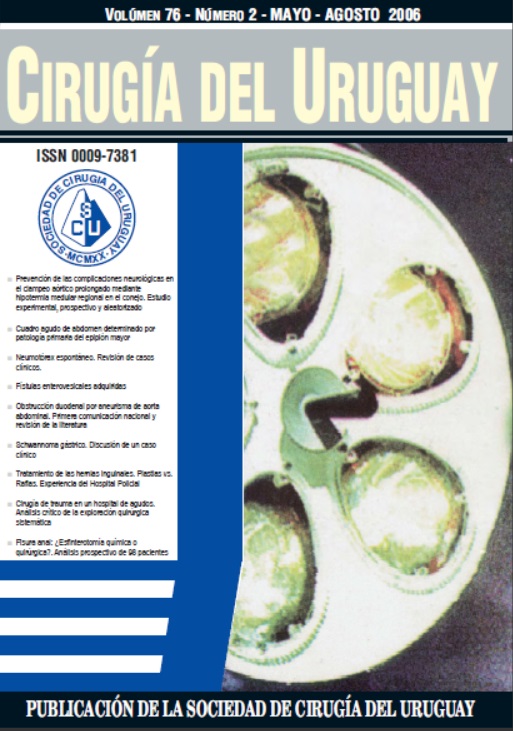Acquired enterovesical fistulas
Keywords:
intestinal fistulaAbstract
12 patients with acquired enterovesical fistulas
during a period between 1990 and 2002 were reviewed., considering etiological aspects, clinical
presentation, paraclinical examinations and surgical
treatment and comparing them with those in
similar published series.
Etiology includes diverticular disease (six cases),
Crohn’s disease (three cases), radiation injury
(one case) and surgical or instrumental iatrogenia
(two cases).
Specific symptoms and the clinical presentation
were related to the causal disease.
Paraclinical examinations were analysed. The
importance of computerized abdominal tomography
is emphatically stressed.
Finally, treatment and outcomes were considered.
In all cases surgery was performed. The most
common procedure (75%) was intestinal resection
with primary anastomosis (one-stage resection) and
vesical repair. Other procedures were colostomy
without resection (16%) and resection without
anastomosis (8%).
No mortality was registered and the outcome
was favourable in all cases. The functional results
were better in one-stage resection cases.
We concluded that enterovesical fistula is a rare
disease. Etiology and relative frequency is similar
to those in other published series with the only difference
that no neoplastic fistulas were found..
Surgical treatment is effective and one stage resection
and anastomosis is recommended if possible
because the better functional outcome
Downloads
Metrics
Downloads
Published
How to Cite
Issue
Section
License
All articles, videos and images published in Revista Cirugía del Uruguay are under the Creative Commons CC licenses, which is a complement to the traditional copyright, in the following terms: first, the authorship of the referred document must always be acknowledged and secondly none of the article or work published in the journal may have commercial purposes of any nature. The authors retain their copyrights and give the magazine the right of first publication of their work, which will be simultaneously subject to the Creative Commons Attribution-NonCommercial 4.0 International License license that allows the work to be shared whenever the initial publication is indicated in this journal.


























